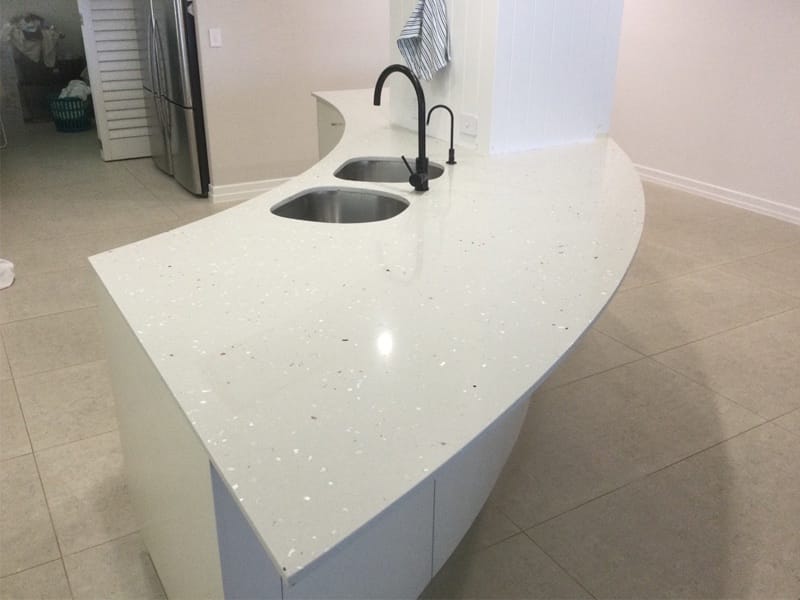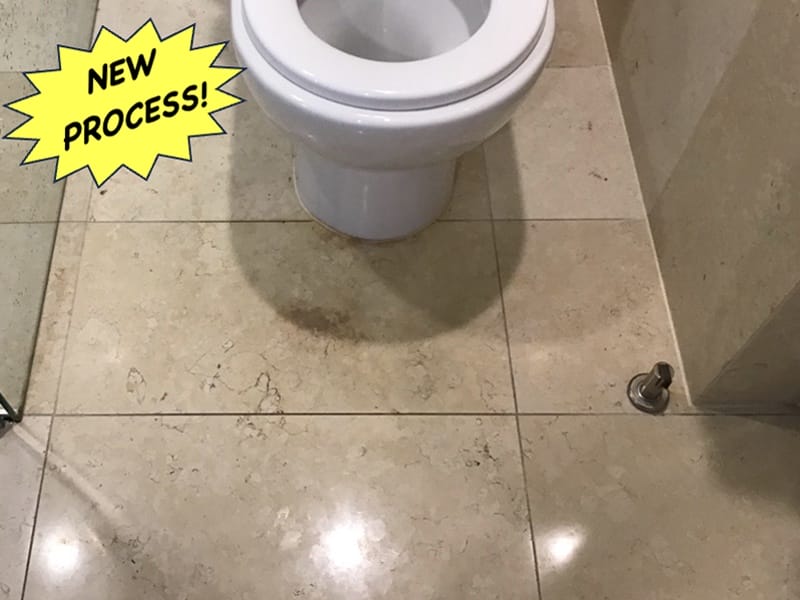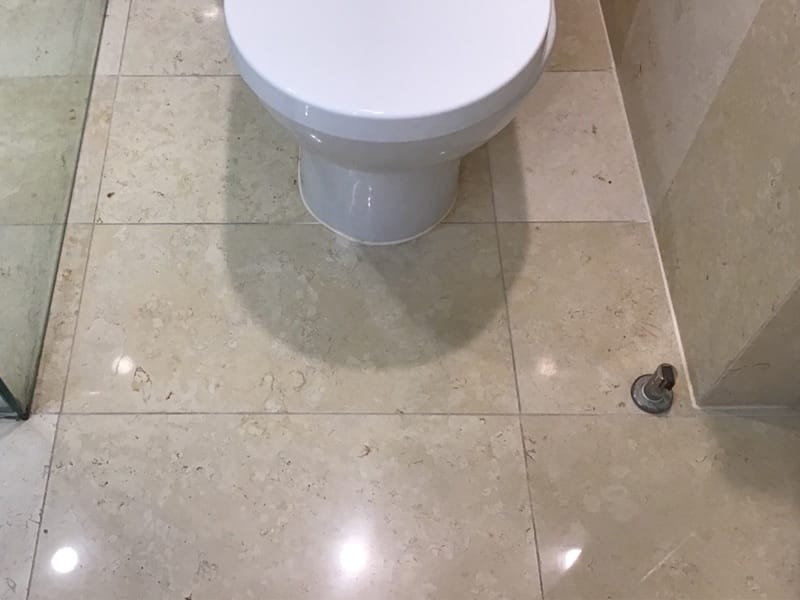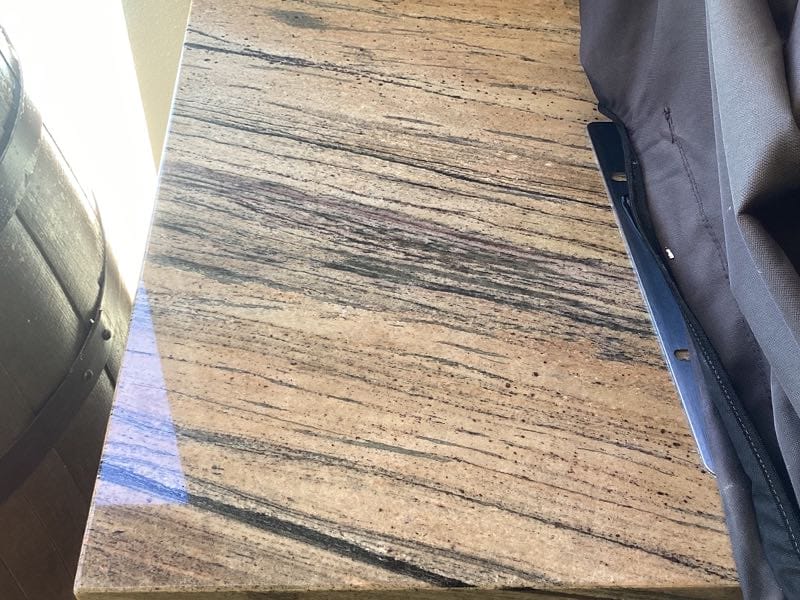

Has your Caesarstone kitchen benchtop turned yellow or developed stains ?
The Marble Man specialises in stone stain removal, targeting yellowing and stains on Caesarstone and all engineered stone benchtops and countertops. Over many years, our team has conducted research into why engineered stones yellow and stain and how to remedy this common issue.
Finally, after around 10 years of trial and error, our team has perfected a stone stain removal process for returning discoloured stone back to its original colour. We call this process the Fusion Poultice. We now regularly achieve a 95% positive result using this process.
Which types of benchtops are affected?
Caesarstone, Essastone, Silestone, Quantum Quartz, HanStone, Neo Stone or any engineered stone can discolour over time, depending on use and care. Discolouration can take from 8 to 10 years or more to develop depending on the conditions. Often the yellow effect is so slight over many years that it is not noticed until the surface is compared to a new piece of stone. Our stone stain removal Fusion Poultice can successfully remove all of this discolouration.
Why does engineered stone turn yellow and stain?
There are a number of reasons why engineered stone will discolour:
- Incorrect cleaners are the main reason. Generic, non-stone specific cleaners can contain acidic chemicals that can damage the stone. These cleaners react with the resins contained within the stone. Only recommended stone cleaners should be used to maintain your stone.
- Dish water with detergent constantly dripping from a dish drainer can cause the area around the sink to go brown or yellow. When a cleaner is sprayed on the area to try to remove this it doubles the effect and makes the stone even more yellow.
- Caesarstone or other engineered stones that have been installed outdoors, even if undercover, will darken or turn yellow.
How does the Fusion Poultice remove yellowing and staining?
Professional stone stain removal is the only way to return your yellow and stained engineered stone benchtop back to its original colour. Our Fusion Poultice is designed to penetrate deeper into the stone than a professional stone cleaner, and far deeper than resurfacing will allow. As it sits on the stone it draws out the yellowing and staining from below the surface, and returns the stone to its original, lighter non-yellow colour.
What is the Fusion Poultice process?
Step 1 Engineered stone benchtop is cleaned with a solution especially developed by The Marble Man, for yellowing stone, to remove superficial staining.
Step 2 Poultice is prepared and applied to the surface so it covers the entire benchtop or stain, depending on the area to be treated.
Step 3 Poultice is removed after a period of time determined by the level of staining, and the surface cleaned.
Step 5 Surface is then resealed to protect it from future surface staining.
If your Caesarstone or other engineered stone benchtop is showing signs of yellowing, staining from cleaning and general wear and tear, call or email us today for a free stone care evaluation. The Marble Man’s Fusion Poultice could save you thousands of dollars in stone replacement costs.
EMAIL OR CALL US NOW! 1300 627 626


Do you have yellow and brown stains around your toilets, showers and basins?
The Marble Man has extensive experience in stone stain removal and restoring natural stone bathroom wall and floor tiles and vanities, that have developed yellow or brown stains.
Over the past 30 years, our team of technicians has discovered through experience, why natural stone in the bathroom develops discolouration. As a result, we have developed a stone stain removal process called a Reactive Poultice, which successfully improves the look of these unsightly stains.
Which natural stones will discolour in the bathroom?
Marble, limestone, travertine and onyx, are commonly used in bathrooms on walls, floors and vanities, but can discolour over time.
Why do these natural stones turn yellow and brown?
There are a number of reasons why marble and other natural stones used in bathrooms, develop yellow and brown stains around toilets, showers and basins:
- During the wet and dry cycle in a shower, moisture can penetrate through old or damaged grout and silicone and settle under the tiles. Sometimes an undetected water leak can be present from a pipe behind the tiles. Over time, the water causes the iron content in the stone to leach up through the stone. This is one cause of the yellow and brown staining.
- Around the basin on a stone vanity, water can penetrate under the benchtop around an underslung sink, or around the taps. As with the shower the iron content rises up through the stone.
- Water around the base of the toilet from a leak or from urine can penetrate into the stone. Cleaners can also have an effect due to their acid content.
- Using chemical cleaners not designed for natural stone can also cause discolouration in all of the above areas. Only use recommended products on your natural stone surfaces.
How does the Reactive Poultice remove yellow and brown stains?
The Reactive Poultice applied by The Marble Man, is designed to penetrate porous natural stone and to draw out the staining. The chemicals in the poultice will react with the stone and the iron content, fading and drawing out the yellow and brown stains.
What is the Reactive Poultice process?
Step 1 Natural stone surface is cleaned thoroughly with a professional cleaner.
Step 2 Reactive Poultice is prepared and applied to the area, then left for a specific period, depending on the area, the type of stone and the level of discolouration.
Step 3 Reactive Poultice is removed by the technician and the result checked to ensure another poultice does not need to be added. Sometimes it is difficult to remove the entire stain, therefore a second poultice may be required.
Step 4 Surface is repolished or honed, to reveal a smooth, clean and stain free surface.
Step 5 Stone is then sealed with a penetrating sealer to help prevent future moisture from penetrating the surface.
If your natural stone bathroom floor and wall tiles or vanity are showing signs of yellowing or staining call or email us today for a quote. The Marble Man’s Reactive Poultice could be the solution you need.
EMAIL OR CALL US NOW! 1300 627 626


Are dark oil stains ruining the look of your stone kitchen countertop or floor tiles?
The Marble Man can successfully remove unsightly, dark oil stones from your marble kitchen benchtop, countertop or floor tiles, using a special stone stain removal process we have developed, called an Oil Drawing Poultice. Through research and development over many years, we have created this process to remedy the problem of oil soaking into natural stone, in kitchens and bathrooms.
Which natural stones develop dark oil stains?
Marble, limestone, travertine, granite, onyx, quartzite and other natural stones commonly used in the kitchen on benchtops, island benches, as splashback tiles and floor tiles, are susceptible to developing oil stains.
How do dark oil stains develop on marble, granite and other natural stones?
- Around stove tops, where oil is sprayed and splattered or oil bottles are left sitting, patches and ring marks can develop over time.
- Food that is prepared on benchtops, countertops and island benches, without a cutting board, such as salad dressings, fish or baked goods using butter or oil, can leave a residue that will soak into the stone. Even with a cutting board, spillage is often unavoidable.
- On floor tiles, over time, oil stains are often found on the floor near the kick under the benchtop or island bench, around the stove, the preparation area or sink.
How does the Oil Drawing Poultice remove dark oil stains from natural stone?
Dark oil stains cannot be removed by cleaning alone, as oil soaks deep into porous stone over time. It can only be removed with a professional treatment. The Marble Man Oil Drawing Poultice, developed over many years, and trialled on many different natural stones, can successfully draw out the oil. The chemicals in the poultice react with the oil when left on for a period of time.
What is the Oil Drawing Poultice process?
Step 1 Natural stone surface is firstly cleaned with a professional cleaner, to remove any oily residue and debris.
Step 2 Oil Drawing Poultice is applied to the dark oily stains, for a period of time, depending on the area and level of staining.
Step 3 Surface is checked after Oil Drawing Poultice is removed, to ensure another poultice is not needed. If all stains have been removed the surface will be prepared for polishing.
Step 4 Polishing is usually recommended after an Oil Drawing Poultice, to remove all scratches and any other damage.
(Granite and Quartzite does not require polishing, only the more porous stones such as marble, limestone, travertine and onyx).
Step 5 After polishing is complete the stone surface is sealed to minimise further staining and prolong the surface of the stone.
When dark oil stains begin to ruin the look of your marble or other natural stone benchtop, countertop or floor tiles, call or email us today for a free stone care evaluation. Our Oil Drawing Poultice will restore the smooth feel to your stone and leave it looking bright, fresh and clean.
EMAIL OR CALL US NOW! 1300 627 626
MASTER BUILDERS QLD MEMBER

HIA QLD MEMBER

TUFFSKIN APPROVED APPLICATOR

AQUAMIX APPROVED APPLICATOR

DRYTREAT APPROVED APPLICATOR


